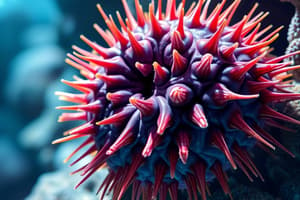Podcast
Questions and Answers
What does Phylum Echinodermata mean?
What does Phylum Echinodermata mean?
- Smooth skin
- Spiny skin (correct)
- Soft skin
- Hard shell
What is Class Echinoidea?
What is Class Echinoidea?
Sea Urchin
What are spines?
What are spines?
Non-movable projections on the exoskeleton
What is the function of teeth in sea urchins?
What is the function of teeth in sea urchins?
Where is the anal plate located on a sea urchin?
Where is the anal plate located on a sea urchin?
What is a madreporite?
What is a madreporite?
What are gills in sea urchins?
What are gills in sea urchins?
What is the mouth in sea urchins?
What is the mouth in sea urchins?
What are buccal podia?
What are buccal podia?
What is the function of the anus in sea urchins?
What is the function of the anus in sea urchins?
What are genital plates?
What are genital plates?
What is Aristotle's lantern?
What is Aristotle's lantern?
What are the trophic differences between sea stars and sea urchins?
What are the trophic differences between sea stars and sea urchins?
Flashcards are hidden until you start studying
Study Notes
Phylum Echinodermata
- Known as "spiny skin" organisms, characterized by their hard, calcareous exoskeletons.
- Includes various marine animals, exhibiting radial symmetry in adult forms.
Class Echinoidea (Sea Urchins)
- Commonly referred to as sea urchins, which are small, spiny creatures inhabiting ocean floors.
Spines
- Non-movable projections that serve as protection and aid in mobility.
- Made of calcified material, contributing to the exoskeleton structure.
Teeth
- Located in the oral cavity, specifically designed for grinding food.
- Integral part of the feeding mechanism in sea urchins.
Lip
- The term is left undefined but refers to potential structures around the mouth.
Anal Plate
- Positioned on the "top" of the sea urchin's body.
- Plays a role in the anatomy and excretory function of the organism.
Madreporite
- A sieve-like structure that connects the water vascular system to the external environment.
- Critical for regulating water intake and pressure within the system.
Gills
- Extensions of the body designed for respiration, featuring thin-walled blood vessels.
- Facilitate efficient absorption of oxygen from surrounding water.
Mouth
- The oral opening through which sea urchins ingest food.
- Located on the underside of the body, highlighting the organism's feeding behavior.
Buccal Podia
- Oral tube feet that assist in feeding and movement.
- Enable sea urchins to grip surfaces and manipulate food.
Anus
- Muscular opening at the end of the rectum for waste elimination.
- Essential for digestive functions and waste management.
Genital Plates
- Larger plates that encompass reproductive structures, including the madreporite.
- Facilitate water entry into the water vascular system through specialized pores.
Aristotle's Lantern
- A unique feeding structure made up of muscle-operated calcareous plates and jaws.
- Provides an effective mechanism for sea urchins to scrape algae and other organic materials.
Trophic Differences Between Sea Stars and Sea Urchins
- Sea stars are relatively unselective carnivores, consuming mollusks, crustaceans, and small fish.
- Sea urchins primarily feed on algae and organic material, playing different ecological roles in their habitats.
Studying That Suits You
Use AI to generate personalized quizzes and flashcards to suit your learning preferences.




